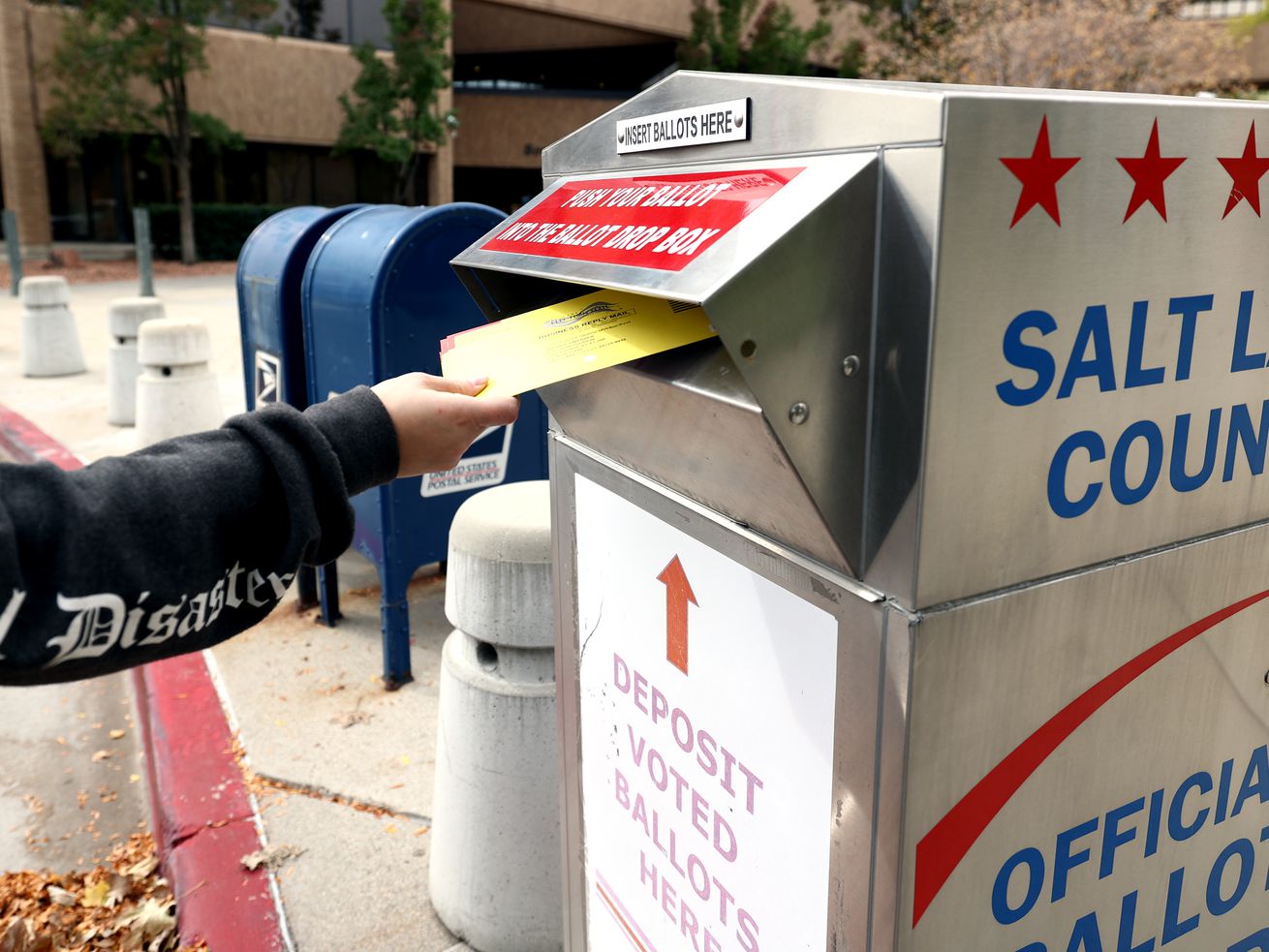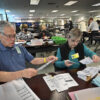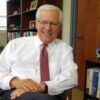| Scott G Winterton ∙ Deseret News |
Ranked choice voting made its debut across 21 Utah municipalities Tuesday. And while the results are still preliminary, we’re starting gauge how Utah clerks, voters and candidates feel about the system that’s been touted as a way to save cities money, increase voter participation, and create a more civil campaign process.
”We are more than pleased that we had six more cities opt in.
A voter drops a ballot into a box at the Salt Lake County Government Center in Salt Lake City on Monday, Oct. 18, 2021.
“I think it went really well. I was actually pleasantly surprised,” said Salt Lake County Clerk Sherrie Swensen, whose office oversaw nine municipalities piloting ranked choice voting — Bluffdale, Cottonwood Heights, Draper, Magna, Midvale, Riverton, Salt Lake City, Sandy and South Salt Lake.
“As with anything, trying new things comes with small hiccups, but we worked through those, we were happy with the release times that we had last night and I’m personally very happy with how awesome the process looks online,” said Taylor Williams, chief deputy clerk for Utah County. Elk Ridge, Genola, Lehi, Springville, Vineyard and Woodland Hills are among the Utah County towns that participated in ranked choice voting this election.
Like Williams eluded, the process hit a few potholes. For one, it was a lot more work for the clerk’s staff, mainly in the weeks leading up to the election. Swensen said formatting the ballots “so that it was easy for the voters to understand” took time, especially when a service district overlapped with a municipal election.
“It looked really odd when we had to put a standard contest next to a ranked choice contest,” she said.
Williams said it was “a little more work.” Not enough to delay the release of preliminary results, but between election prep, clarifying voter intent and flagging mistakes on ballots, Utah County staff had an extra busy election night.
Swensen said her office couldn’t employ the vendor used in past elections to display the ranked choice results because it didn’t accommodate the system — meaning that in the Salt Lake City Council races, candidates didn’t know the precinct level results.
“We need that information,” said Blake Perez, candidate for Salt Lake’s district 1 race, which on Tuesday emerged as the closest of the city’s five council elections.
“We need to know that our strategy worked where we were targeting. … When it comes down to this kind of a race, that precinct-level data is critical, and I hope there are some adjustments made, and we can get our hands on that information,” he said.
The race featured three candidates — Perez, Victoria Petro-Escheler and Richard D.M. Barnes. Petro-Escheler currently holds a 138-vote edge over Perez.
According to preliminary results released at 10 p.m. Tuesday, Barnes received 252 first choice votes, and will likely be eliminated — although Swensen stressed candidates are “really not eliminated until we get all the ballots that are eligible tabulated.”
Petro-Escheler received 1,109 votes, and Perez 971. According to Salt Lake County’s ranked choice voting simulator, Perez will pick up slightly more second-choice votes from Barnes’ elimination, putting him at 1,082 (47.6%) but still behind Petro-Escheler at 1,192 (52.4%).
Both candidates couldn’t say whether a standard election would give them a better outlook on where they stand. Both candidates expressed some concerns with the process, And both candidates said there were benefits.
“In district 1, historically it’s hard for them to make sure their voices are heard consistently, and I did love that with ranked choice voting, it really gave them a chance to amplify their voices, to give not just a binary choice, but to participate in a more robust way,” said Petro-Eschler.
But Petro-Eschler also noted that the ranked choice model added more work to her already busy campaign — explaining to constituents that it’s OK to pick multiple candidates, the financial benefits of skipping a primary, “and making the case that this was a safe and evidence-based way to cast your vote even if it was a little different. But it did require energy from us to educate.”
Perez says it was hard to gauge how the district 1 voters he spoke with felt about the new system.
“There was no clear consensus on ranked choice voting. A lot of people were frustrated. A lot of people support it,” he said. While it’s frequently lauded as a way to increase civility on the campaign trail, he said there is a difference between what candidates say in public, and what they say while canvassing.
“We’ve certainly heard whispers of some negative campaigning going on and that’s just at the doors, not a public setting,” he said.
Swensen’s office will release more results Thursday evening. Both candidates are remaining cautiously optimistic for the next 24 hours.
Perez is staying put — “We’re not making any moves, we’re still in this race, and hopeful those ballots fall in our direction,” he said.
Petro-Eschler says she is waiting for more confirmation, but has made a few calls, including to the Westside Community Council leaders, and district 2 candidate Alejandro “Ale” Puy, who holds a strong lead over Billy Palmer.
She says she’s “making sure that when I told my neighbors that I would bring their voice to City Hall, that I am doing that in whatever capacity I am allowed to at this point.”
How ranked choice voting came to Utah — and what’s next
In 2018, former Gov. Gary Herbert signed HB135, which received almost no pushback from lawmakers and allowed municipalities to pilot ranked choice voting and instant runoff programs. In 2019, Payson and Vineyard became the first Utah cities to opt in.
The Utah Legislature then passed HB75 in 2021, which expanded Utah’s ranked choice voting pilot program and gave more cities the ability to opt in.
It’s still too early to tell what the swaths of Utahns who voted in the elections think of ranked choice voting. Williams with Utah County said when Vineyard and Payson piloted the program in 2019, the feedback was generally positive. A survey suggested three-quarters of voters in those municipalities supported either keeping it or expanding it.
“We are more than pleased that we had six more cities opt in, and I think that says a lot that the elected officials in those cities believe their citizens want this and they’re willing to jump on it,” he said, before noting that ”we expect nothing but up up and away.”
There are 22 jurisdictions in the U.S. that used ranked choice voting in their most recent election, and 20 more used it for the first time in November, according to the nonpartisan group FairVote.
That includes Alaska and Maine, where ranked choice voting is used for statewide and presidential elections, and Nevada, Kansas and Wyoming, where it was used for the 2020 presidential primary.
The group projects at least 50 jurisdictions will use ranked choice voting in either their next election or the one following.





